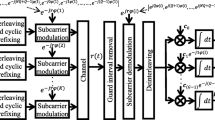Abstract
This paper addresses the problem of detecting a new user in time-hopping multiple access communication environment targeted for ultra wideband impulse radio (IR) systems. The proposed detector is based on exploiting the orthogonality between the new user and the other active user(s) in frequency domain. This is because the time-domain orthogonality is destroyed due to the long delay spread of a dense multipath channel experienced by IR transmission. This results in the presence of inter-frame, inter-path as well as inter-symbol interferences. To ensure the frequency-domain orthogonality, we propose a TH code design as a means of encoding a unique spectrum that is orthogonal to each user. Simulation results highlight the note-worthy improvement in frequency-domain detection performance that utilizes our proposed design algorithm. This gain is obtained without any significant increase in computational complexity or hardware costs. Unlike the rake detector, the frequency-domain detector does not require the time-of-arrival information of the multipath components.
Similar content being viewed by others
References
Halford K.W., Brandt-Pearce M. (1998) New-user identification in a CDMA system. IEEE Transactions on Communications, 46(1): 144–155. ISSN 0090-6778 (Jan). doi:10.1109/26.655413
Mitra U., Poor H. V. (1996) Activity detection in a multi-user environment. Wireless Personal Communications Journal 3(1-2): 149–174
Win M.Z., Scholtz R.A. (2000) Ultra-wide bandwidth time-hopping spread-spectrum impulse radio for wireless multiple-access communications. IEEE Transactions on Communications, 48(4): 679–689. ISSN 0090-6778 (Apr). doi:10.1109/26.843135
Biglieri E., Lops M. (2007) Multiuser detection in a dynamic environment part I: user identification and data detection. IEEE Transactions on Information Theory, 53(9): 3158–3170. ISSN 0018-9448 (Sept). doi:10.1109/TIT.2007.903115
Xin L., Teh K.C., Gunawan E. (2007) Performance analysis of blind-adaptive-subspace multiuser detectors over multipath fading channels. IEEE Transactions on Vehicular Technology, 562: 631–640. ISSN 0018-9545 (March). doi:10.1109/TVT.2006.889580
Zarringhalam F., Seyfe B., Shikh-Bahaei M., Charbit G., Aghvami H. (2009) Jointly optimized rate and outer loop power control with single- and multi-user detection. IEEE Transactions on Wireless Communications, 81: 186–195. ISSN 1536-1276 (Jan). doi:10.1109/T-WC.2009.070669
Gezici S., Tian Z., Giannakis G.B., Kobayashi H., Molisch A.F., Poor H.V., Sahinoglu Z. (2005) Localization via ultra-wideband radios: A look at positioning aspects for future sensor networks. IEEE Signal Processing Magazine 22(4): 70–84. ISSN 1053-5888 (July). doi:10.1109/MSP.2005.1458289
Sahinoglu Z., Guvenc I. (2006) Multiuser interference mitigation in noncoherent uwb ranging via nonlinear filtering. EURASIP Journal on Wireless Communications and Networking, 2006(2): 67–67 ISSN 1687-1472
daSilva C.R.C.M., Milstein L.B. (2005) Spectral-encoded UWB communication systems: real-time implementation and interference suppression. IEEE Transactions on Communications 53(8): 1391–1401. ISSN 0090-6778 (Aug). doi:10.1109/TCOMM.2005.852822
Lie J. P., Ng B. P., See C. M. S. (2008) Multiple UWB emitters DoA estimation employing time hopping spread spectrum. Progress in Electromagnetics Research 78: 83–101
Molisch, A. F. (2004). IEEE 802.15.4a channel model-final report. Technical Report IEEE 802.15-04-0662-01-04a, IEEE P802.15 Working Group for Wireless Personal Area Networks (WPANs), (September).
Bellorado, J., Ghassenzadeh, S. S., Kavcic, A., Tarokh, B., & Tarokh, V. (2004). Time-hopping sequence design for narrowband interference suppression. 2004 IEEE 60th Vehicular Technology Conference. VTC2004-Fall, 6, 3925–3929, ISSN 1090-3038 (Sept). doi:10.1109/VETECF.2004.1404813.
Piazzo, L., Romme, J. (2003). Spectrum control by means of the TH code in UWB systems. The 57th IEEE Semiannual Vehicular Technology Conference, 2003. VTC 2003-Spring, 3, 1649–1653, ISSN 1090-3038 (April).
Sheng, H., Orlik, P., Haimovich, A. M., Jr. Cimini, L. J., & Zhang, J. (2003). On the spectral and power requirements for ultra-wideband transmission. IEEE International Conference on Communications ICC ’03, 1, 738–742, (May).
Kay S. M. (1998) Fundamentals of statistical signal processing: Detection theory, volume II. Prentice-Hall, Upper Saddle River, New Jersey, p 07458
Benedetto M-G. D., Giancola G. (2004) Understanding ultra wide band radio fundamentals. Prentice Hall Ptr, USA
Oppenheim, A. V., Schafer, R. W., & Buck, John R. (1999) Discrete-time signal processing (2nd ed.). NJ, USA: Prentice-Hall, Inc., Upper Saddle River. ISBN 0-13-754920-2.
Chugh, M., Bhatia, D., & Balsara, P. T. (2005). Design and implementation of configurable w-cdma rake receiver architectures on fpga. Parallel and Distributed Processing Symposium, 2005. 19th IEEE International Proceedings, 145b–145b. doi:10.1109/IPDPS.2005.162.
Author information
Authors and Affiliations
Corresponding author
Rights and permissions
About this article
Cite this article
Lie, J.P., Ng, B.P. & Lim, CH. New-User Detection in Time Hopping Multi-User Environment for UWB Impulse Radio Systems. Wireless Pers Commun 55, 121–134 (2010). https://doi.org/10.1007/s11277-009-9780-6
Received:
Accepted:
Published:
Issue Date:
DOI: https://doi.org/10.1007/s11277-009-9780-6




